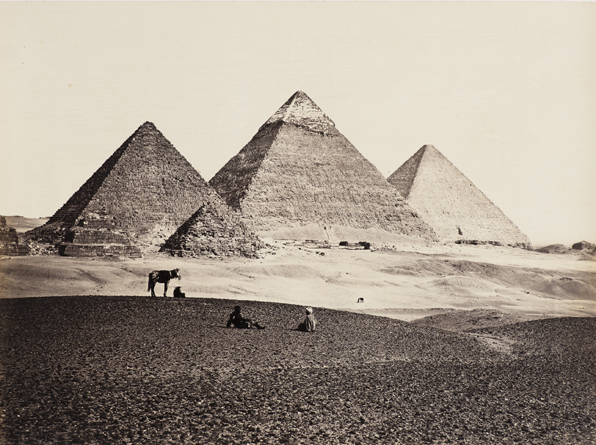
November 12, 2016–February 5, 2017
Places
Photography allowed people to visualize places in ways previously unimaginable. From the pyramids of Egypt to the waterfalls of California, nineteenth-century photographers captured images of sites for many reasons: documentation, science, commerce, politics, and art. For example, Linnaeus Tripe, a captain in the British army, became an official photographer for the British government as it expanded its colonial reach throughout India. In 1855 Tripe accompanied an expedition that sought further annexation under British rule. His commission was to produce photographic surveys of architecture in Burma (modern-day Myanmar). While his role was ostensibly to document, Tripe selected dramatic views and used modern compositional devices in Amerapoora, A Street in the City to create this image of Burmese Buddhist architecture. Tripe often retouched his negatives and printed his photographs with evocatively grainy textures and artfully manipulated skies.
Similarly, Frances Frith strove to document the The Pyramids of El-Geezeh for his publication Egypt, Sinai and Jerusalem: A Series of Twenty Photographic Views (1858), marketed to armchair travelers back home in England. The impetus to create these works was largely commercial and Frith composed his imagery in ways that would have simulated traditional conventions in painting.
Frith created his glass plates under trying circumstances, coating them with albumen emulsions in extremely high temperatures and developing them in a makeshift cart. In contrast to Frith’s laborious efforts, amateur photographers like Félix Thiollier could take and process photographs with relative ease and speed using the gelatin silver print process. Whereas Frith and Tripe’s subjects had to remain still for their images to be transferred to a photographic negative, the factory smoke billowing in the background and the moving figures in the foreground of Thiollier’s Universal Exhibition, Paris 1900 could be transferred to a negative in an instant.
Linnaeus Tripe (English, 1822–1902), Amerapoora, A Street in the City, 1885. Clark Art Institute, 2011.1
Frances Frith (English, 1822–1898), The Pyramids of El-Geezah, c. 1860. Clark Art Institute, 1998.42.3.12
Félix Thiollier (French 1842–1914), Universal Exhibition, Paris 1900, 1900. Clark Art Institute, 2007.15.11




-jpg.jpg)